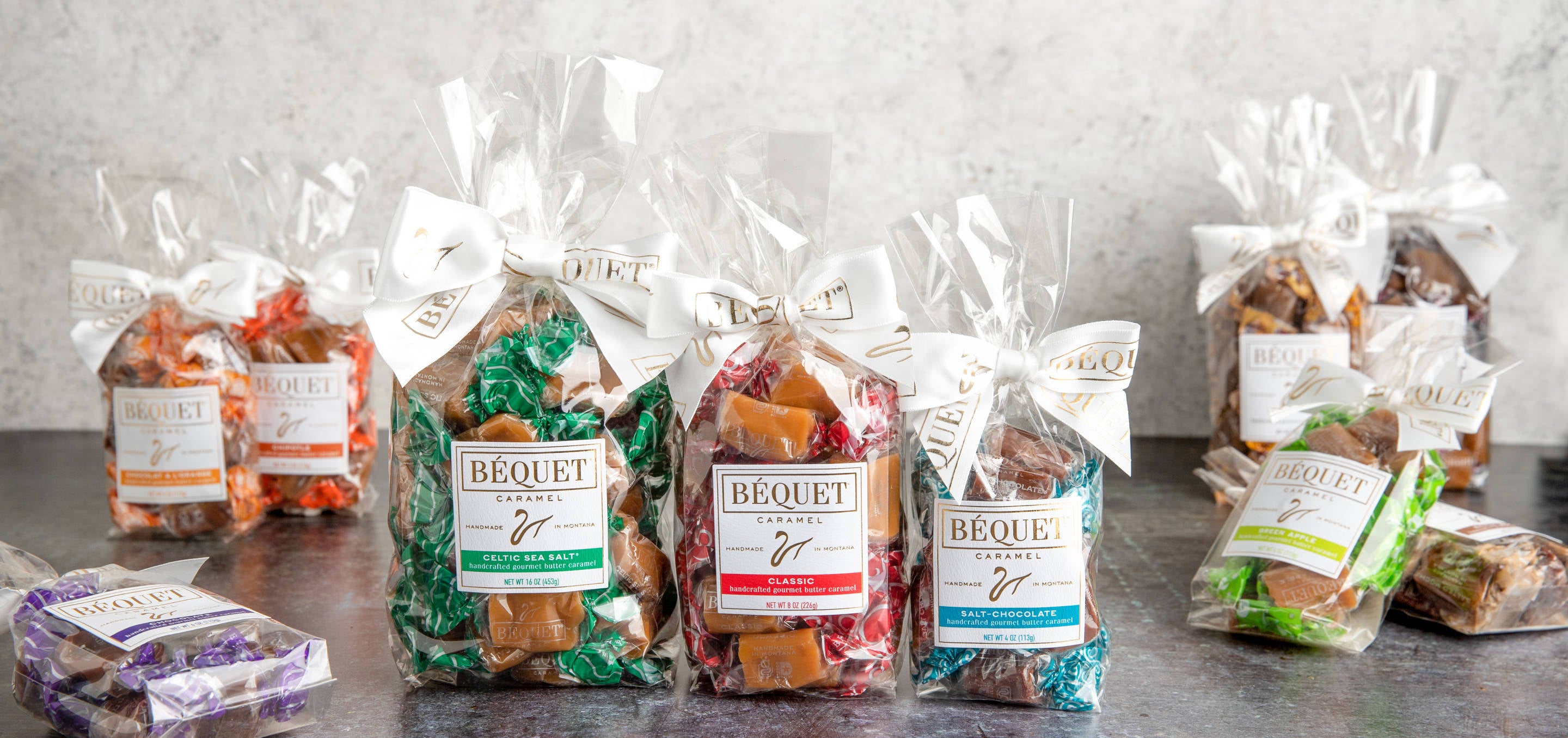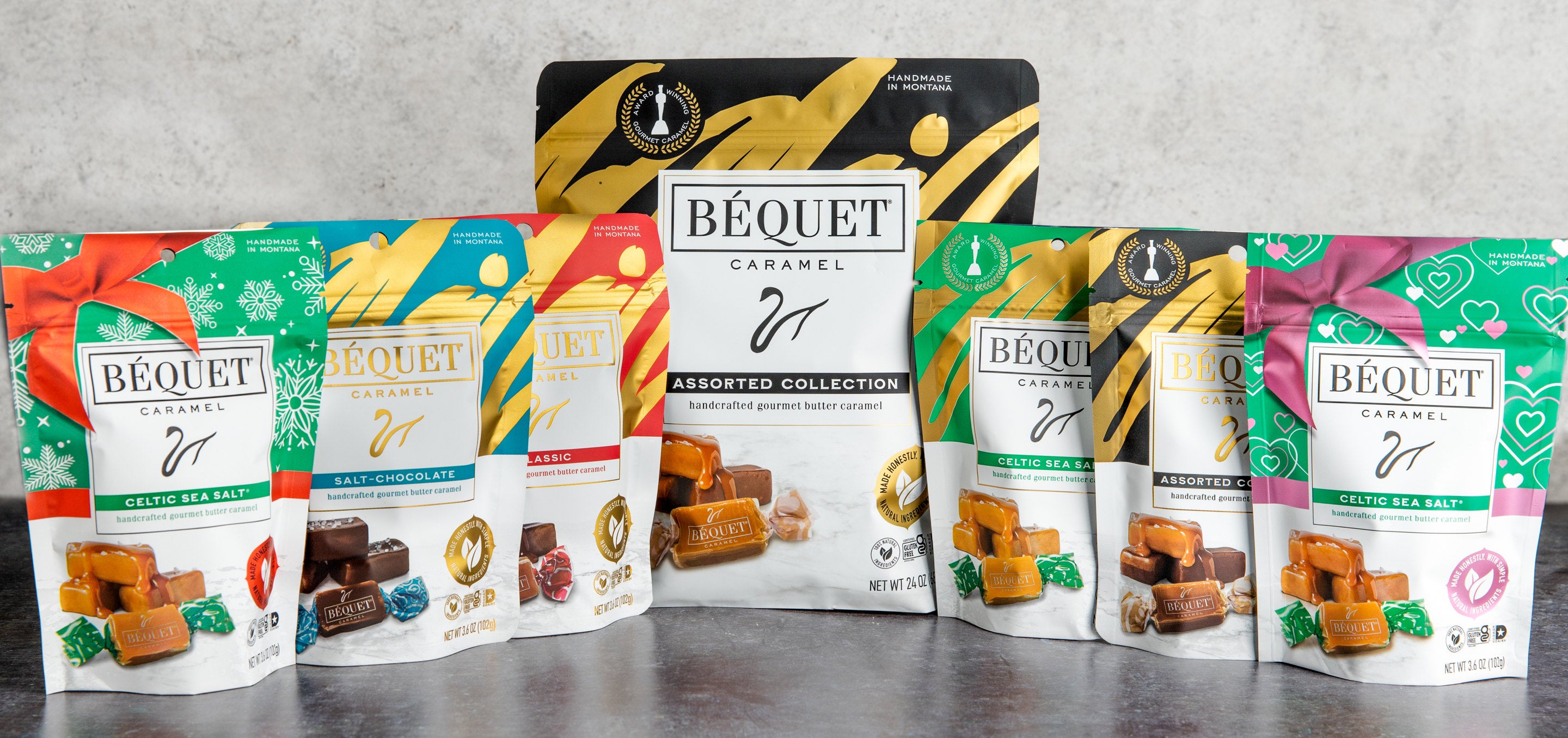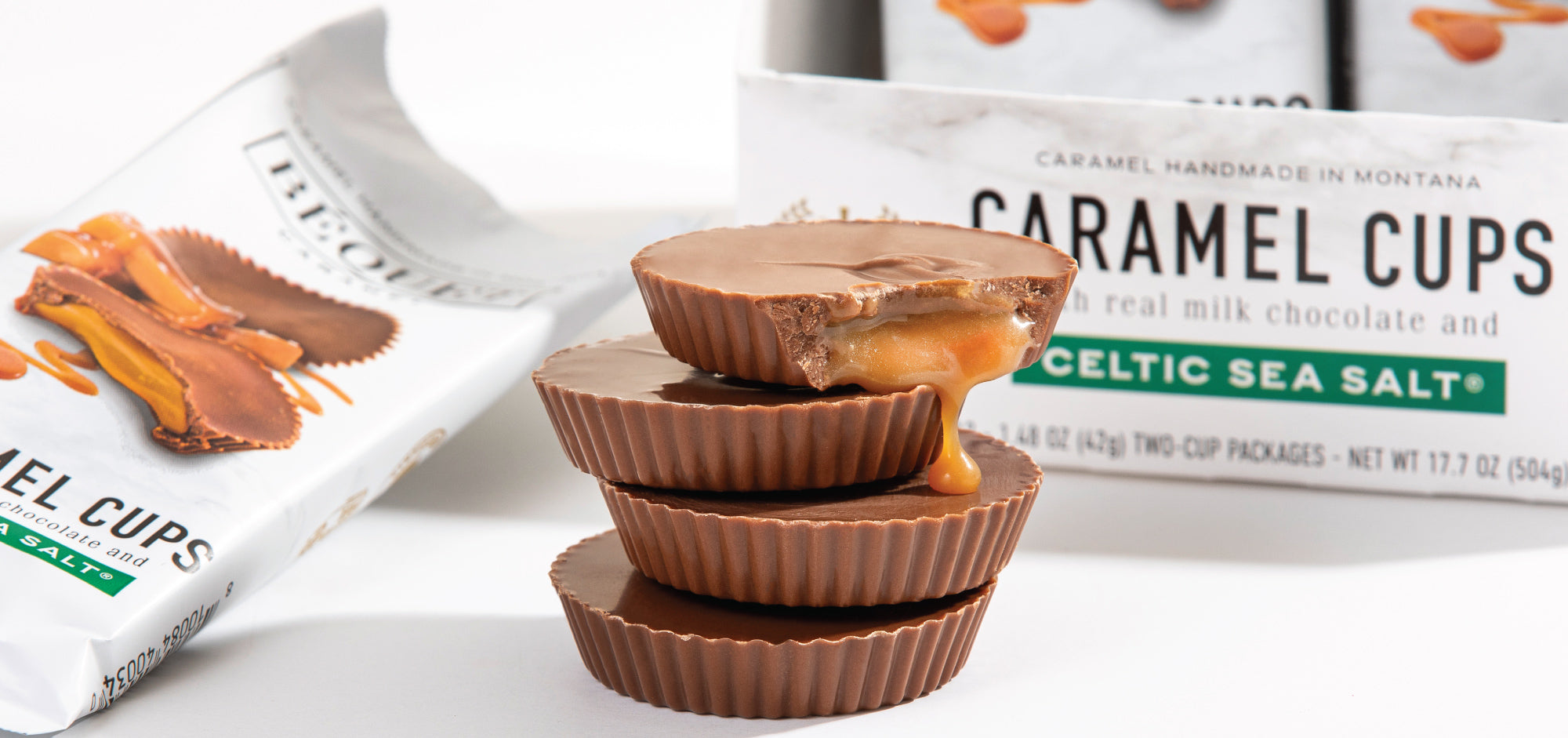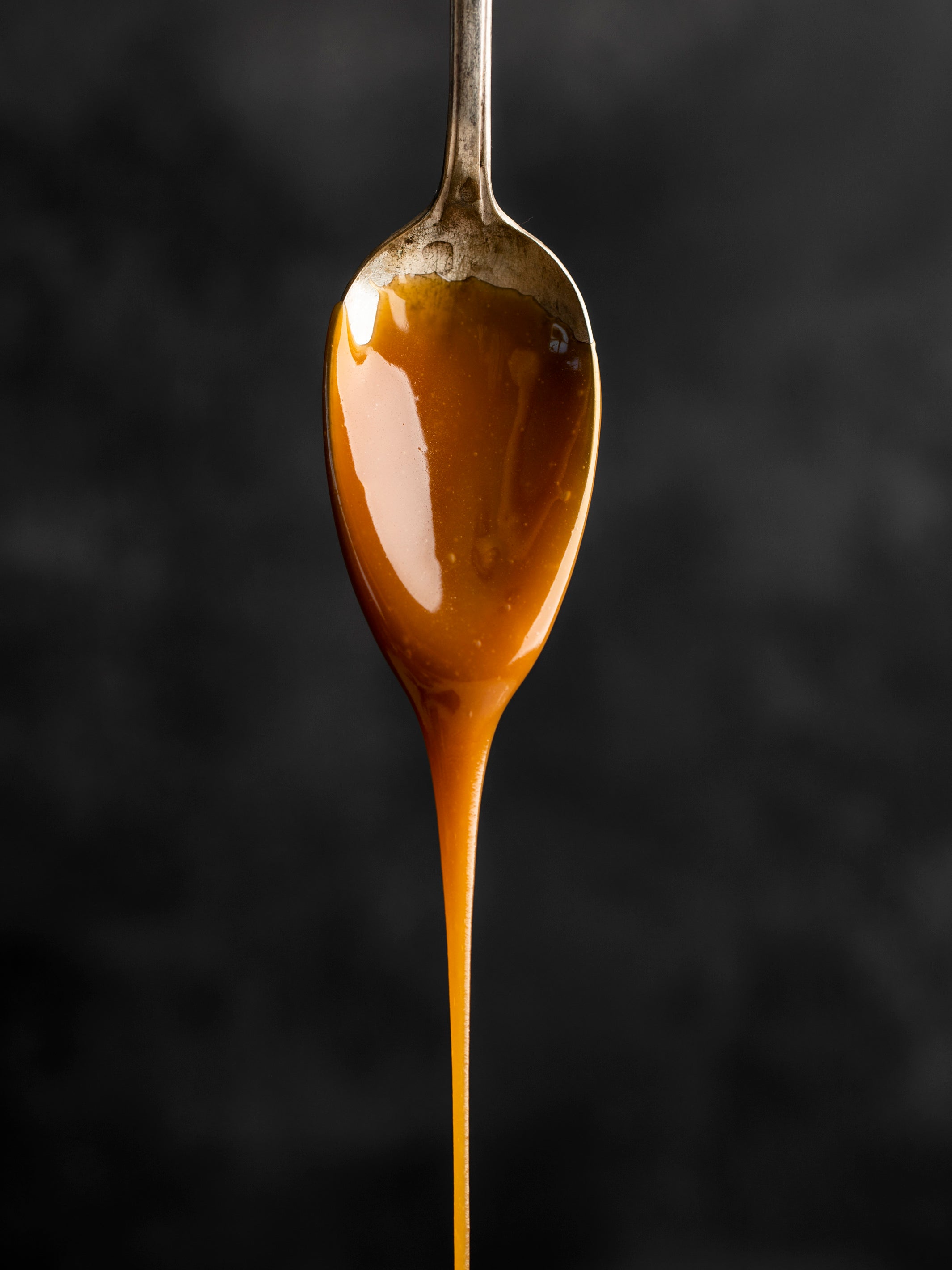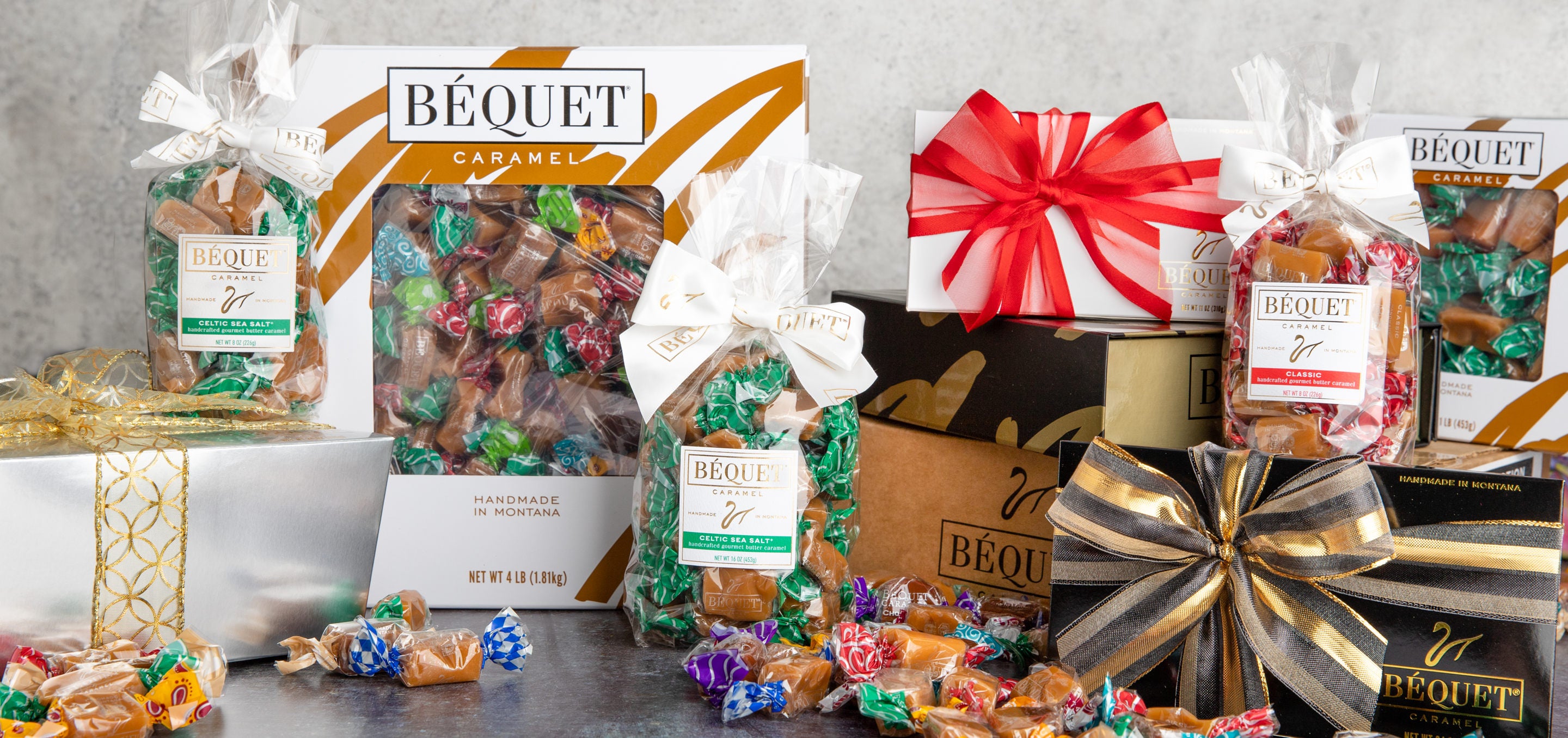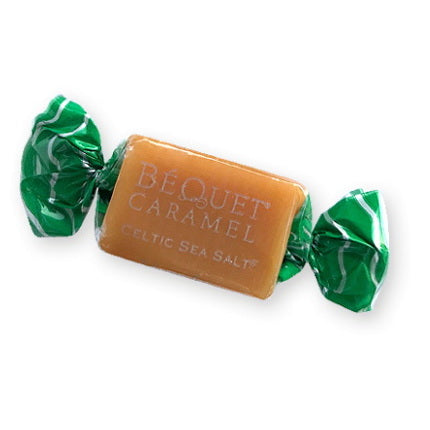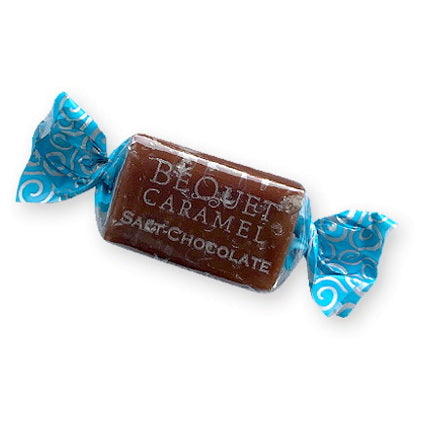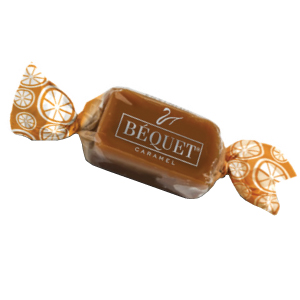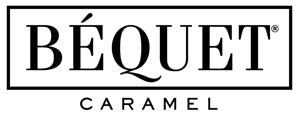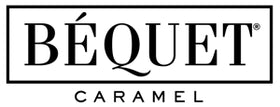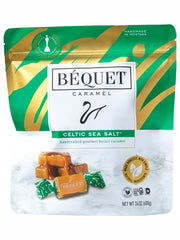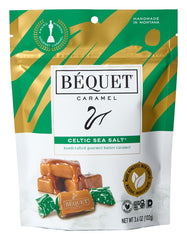Key Takeaways:
- Classic Ingredients That Are Naturally Gluten-Free: Classic caramel ingredients such as sugar, butter, and cream are naturally gluten-free. Unless additives complicate the mix in mass-market versions, these foundational elements typically pose no risk for those with gluten sensitivities.
- Watch For Hidden Additives & Thickeners: Additional flavorings, colorants, and thickeners in mass-produced products can introduce gluten. Always scan the complete ingredient list, especially for syrups, emulsifiers, or “natural flavors” that may be vague or unlabeled.
- Label Awareness Is Your Best Safeguard: Reading product labels closely and recognizing certified gluten-free seals can help you make informed decisions. For anyone with celiac disease or gluten intolerance, certification is essential.
At Béquet, we make caramels slowly because that’s the only way to get them right. Every piece is crafted in Montana using small-batch methods and clean ingredients like antibiotic-free dairy, tapioca syrup, and pure brown sugar. With over a dozen national awards and a loyal customer base, we’ve earned our place not through trends but through precision, quality, and consistency you can taste.
Not all caramel is created equal. Depending on how it’s made, what’s added, or where it’s processed, the answer to, “Is caramel gluten-free?”, can vary more than you’d expect. Ingredient lists don’t always tell the whole story, and cross-contamination is a genuine concern for those with celiac or other sensitivities. If you’re gluten-conscious, there are a few key things to consider before reaching for your next sweet treat.
In this blog, we will explore what makes caramel gluten-free, which ingredients to watch for, how cross-contamination can occur, and how Béquet’s clean production process provides peace of mind for those seeking safe, indulgent sweets.
What Makes Caramel Naturally Gluten-Free?
Caramel, in its purest and most luxurious form, is a simple symphony of high-quality ingredients, including sugar, fresh cream, butter, and a splash of vanilla. These foundational components are naturally gluten-free, meaning they contain no wheat, barley, rye, or their derivatives. When melted and mingled with care, these ingredients create the signature velvety-smooth texture and rich, buttery flavor that caramel lovers crave. For those wondering about butterscotch vs caramel, both share a similar base but can differ in sugar choice and flavor depth — with butterscotch having a darker, richer sweetness, while caramel offers a lighter, creamier taste that remains naturally gluten-free.
Where The Ingredients Come From Matters
The gluten-free nature of traditional caramel comes down to its roots. Sugar is extracted from sugarcane or beets, neither of which contains gluten. Dairy, the heart of creamy caramel, is always gluten-free because of its origin. When used naturally, these ingredients support a recipe that’s both indulgent and safe for gluten-sensitive individuals.
Flavor Additions Don’t Have To Add Risk
Even when ingredients like sea salt, espresso, or chipotle peppers are skillfully added for a gourmet twist, the essence of caramel remains gluten-free, as long as the flavorings themselves are clean. That’s where product transparency and small-batch control make all the difference in maintaining zero caramel gluten content.
Why Ingredient Integrity Defines Gluten Safety
The commitment to clean, real ingredients establishes caramel as a safe, gluten-free indulgence. When recipes avoid unnecessary thickeners, flour, or additives that sometimes sneak into mass-produced confections, the result is a caramel experience that’s pure, decadent, and reassuringly gluten-free, every luscious bite the way it was meant to be.
Key Ingredients: Sugar, Butter, Cream: Any Hidden Gluten?
When you sink your teeth into a piece of silky, rich caramel, the last thing you want to worry about is gluten hiding in the shadows. Classic caramel starts with a foundation of sugar, butter, and cream — the holy trinity of decadent, melt-in-your-mouth deliciousness. None of these ingredients, in their pure form, naturally contains gluten, which is why many people searching, "What is caramel made of?", are relieved to learn that its traditional composition is inherently gluten-free.
Where Hidden Gluten Is Most Likely To Lurk
Glimmers of gluten can truly sneak in through thickeners or stabilizers added during mass production. Modified food starch or malt flavoring, often barley-based, can manipulate texture or shelf life but introduce unwanted gluten. This is especially common in large-scale candy operations, where speed and volume take precedence over purity.
Why Reading Labels Still Isn’t Enough
Gourmet caramel devotees check ingredient lists with a discerning eye and favor options crafted from all-natural, transparent recipes. Ingredient transparency is only part of the story, gluten-conscious customers also value brands that manage cross-contact risks through dedicated gluten-free handling practices.
How Premium Caramel Makers Keep It Clean
Caramel artisans who take pride in their craft are dedicated to purity and simplicity, using only ingredients you’d recognize and trust. When sugar, butter, and cream remain the show's stars, your gluten-free peace of mind is preserved, leaving nothing to distract from the caramel’s velvety, buttery experience.
Recognizing Certified Gluten-Free Seals And What They Mean
When searching for truly indulgent caramel or any sweet treat, knowing how to spot a certified gluten-free seal can make all the difference, especially if you're looking for a gluten-free caramel sauce or similar specialty item where ingredient trust really matters.
Who Regulates Gluten-Free Certification
Several major organizations certify gluten-free products in the United States, including the Gluten-Free Certification Organization (GFCO), the Celiac Support Association (CSA), and the National Celiac Association (NCA). Each group tests and verifies that certified products contain less than 20 parts per million (ppm) of gluten, in accordance with FDA guidelines.
What The Seal Actually Guarantees
These seals confirm more than the absence of gluten ingredients. They indicate that a manufacturer has committed to strict production standards, including regular facility audits and ingredient reviews. Certification ensures that cross-contamination risks are minimized, especially for those managing celiac disease or high sensitivity.
Where To Find The Seals On Packaging
You’ll usually find these seals as bold stamps or small badges on the front or side of the packaging. They're easy to miss but provide meaningful peace of mind. Think of them as visual proof that the product has passed third-party inspection.
How To Interpret A Gluten-Free Claim Without A Seal
Not all “gluten-free” claims are certified. If a product lacks a seal, it may still be gluten-free, but the manufacturer hasn’t undergone the third-party verification process. In those cases, it’s even more important to read the complete ingredient list and check for known sources of gluten.
Béquet’s Commitment To Gluten-Free Indulgence
When it comes to enjoying gourmet sweets, you shouldn’t have to compromise on quality or your dietary needs. Every batch of Béquet caramels begins with a foundation of pure, naturally gluten-free ingredients: pure brown sugar, fresh cream, and butter. No shortcuts, mysterious additives, or gluten-containing elements enter the recipe. For anyone wondering if caramel is safe for celiac, our answer is yes, because we craft every bite with clean ingredients and certified gluten-free handling standards in mind.
A Line Of Products Made For Confidence And Flavor
Whether you’re reaching for a midday indulgence or building a gluten-free dessert board, Béquet’s gourmet caramels offer options that fit the moment. From classic vanilla to adventurous profiles like chipotle or espresso, each is slow-cooked in small batches and crafted to meet gluten-free standards without sacrificing texture, finish, or flavor integrity.
Bulk Caramel Options That Never Compromise
Need to serve a group or keep your pantry stocked? Our bulk caramel lets you enjoy the same award-winning quality in larger quantities. Individually wrapped and made without gluten-containing ingredients, it’s ideal for offices, events, or at-home snacking; safe, delicious, and easy to portion.
Caramel Cups That Balance Chocolate and Assurance
Our caramel cups are another standout. These are our only sea salted caramel chocolates, and they’re made to please sweet and savory palates with their smooth chocolate shell and rich caramel center. Like the rest of our lineup, they’re gluten-free by design and handled in gluten-conscious facilities.
Strict Handling Means No Guesswork
Every caramel is produced in facilities that follow strict gluten-free handling protocols. We’re not casual about cross-contamination. From sourcing to packaging, your safety is built into every process step. For the discerning sweet lover, you don’t have to second-guess.
Why We Treat Gluten-Free As a Standard, Not a Specialty
This standard is a promise in an era when transparency matters more than ever. Whether buying for yourself or gifting someone with dietary sensitivities, Béquet caramels deliver peace of mind wrapped in award-winning flavor. Among gluten-free caramel brands, we offer indulgence without compromise, crafted for those who expect safety and sophistication.
Final Thoughts
The answer to “Is caramel gluten-free?” comes down to craftsmanship and ingredients. At Béquet, our promise is simple: our award-winning caramel delivers pure satisfaction, free from artificial additives and gluten alike.
Crafted in Montana using only the freshest, all-natural ingredients, our caramels are a testament to what happens when passion meets precision. Whether you crave the classic embrace of Celtic Sea Salt® or the daring notes of Salted Mocha, Béquet’s melt-in-your-mouth creations deliver a premium confectionery experience recognized nationwide for both quality and taste.
Pure, decadent, and gluten-free by design.
Frequently Asked Questions About “Is Caramel Gluten-Free?”
Is caramel gluten-free?
Yes, pure caramel is naturally gluten-free. But not all caramel is created equal, so it pays to check the label or ask questions, especially if you have celiac disease or a gluten sensitivity.
What ingredients are typically in caramel?
Classic caramel relies on simple, luxurious ingredients: pure cane sugar or brown sugar, heavy cream, rich butter, and just a kiss of vanilla or salt. Each ingredient is stirred together slowly and steadily to create the famously soft, melt-in-your-mouth texture that Béquet caramels are known and loved for.
Can caramel contain gluten?
It can. While the core components are gluten-free, some commercial caramels or cheap imitations may include flour or gluten-containing thickeners. Flavored caramels, in particular, sometimes sneak in gluten via additives or flavoring blends.
Is store-bought caramel usually gluten-free?
Many store-bought caramels are gluten-free, but there are exceptions. Manufacturers sometimes add stabilizers, caramel color, or flavors containing gluten, so always read the label—and reach for a brand you trust when in doubt.
Are homemade caramel recipes gluten-free?
Most homemade caramel recipes are gluten-free if you stick to basic, premium ingredients: sugar, cream, butter, and optional vanilla or sea salt. If you’re experimenting with fun flavors, double-check each new ingredient for gluten risk.
What brands of caramel are gluten-free?
Béquet Caramel is proudly gluten-free. We make every small batch with care, using only natural, gluten-free ingredients. While other brands may have gluten-free options, it’s always best to check labels and ingredients for clarity.
Does caramel coloring contain gluten?
Caramel coloring in North America is usually gluten-free, as it’s most often made from corn. Rarely, especially overseas, it might be produced with wheat.
